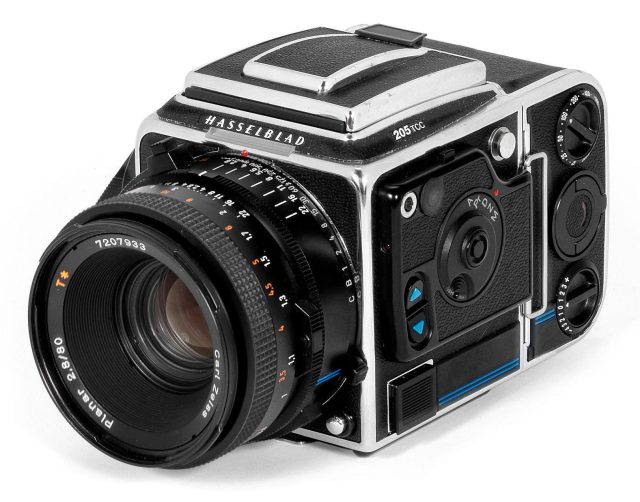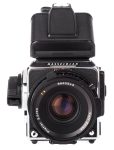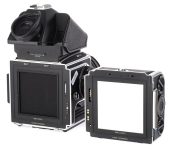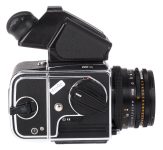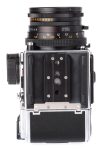Announced
Production status
Order No.
System
Hasselblad V system cameras
- Hasselblad 2000FC
- Hasselblad 2000FC/M
- Hasselblad 2000FCW
- Hasselblad 2003FCW
- Hasselblad 201F
- Hasselblad 202FA
- Hasselblad 203FE
- Hasselblad 205FCC
- Hasselblad 205TCC
- Hasselblad 500 Classic
- Hasselblad 500C
- Hasselblad 500C/M
- Hasselblad 500EL
- Hasselblad 500EL/M
- Hasselblad 500ELX
- Hasselblad 501C
- Hasselblad 501CM
- Hasselblad 503CW
- Hasselblad 503CX
- Hasselblad 503CXi
- Hasselblad 553ELX
- Hasselblad 555ELD
- Hasselblad 903SWC with Carl Zeiss Biogon T* 38mm F/4.5 CF
- Hasselblad 905SWC with Carl Zeiss Biogon T* 38mm F/4.5 CFi
- Hasselblad FlexBody
- Hasselblad SWC with Carl Zeiss Biogon [T*] 38mm F/4.5 C
- Hasselblad SWC/M with Carl Zeiss Biogon T* 38mm F/4.5 C
- Hasselblad SWC/M with Carl Zeiss Biogon T* 38mm F/4.5 CF
Hasselblad 205TCC
Medium format MF film SLR camera • Discontinued
Specification
| Format: | |
| Medium format 6x6 | |
Film type: | 120 roll film |
| 220 roll film | |
| Hasselblad V [74.9mm] | |
| Shutter: | |
Type: | Focal-plane |
Model: | Electronically controlled |
Speeds: | 16 - 1/2000 + B |
| Exposure: | |
Exposure metering: | Through-the-lens (TTL), open-aperture |
Exposure modes: | Aperture-priority Auto |
| Manual | |
| Physical characteristics: | |
Weight: | 1615g |
Dimensions: | 178x118x108mm |
Manufacturer description #1
The Hasselblad 205TCC is the flagship of the current Hasselblad models. It is the first Hasselblad camera with built in exposure automation for existing light and electronic flash. The camera is a true Hasselblad design which means it is compact, lightweight and compatible with the rest of the system. You can therefore add a 205TCC to your existing outfit and use with most or all your other Hasselblad system components.
But the 205TCC is also part of a new system of TCC lenses, TCC magazines, TCC extension tubes, and TCC viewfinders. These are designed to fully utilize all the electronic advantages of the 205TCC camera. All TCC components are characterized by a double blue line.
The 205TCC has the most precise metering system ever built into a camera or an exposure meter. In the Zone mode the Hasselblad 205TCC is also the first camera to incorporate Zone system metering. It provides photographers with a precise and simple method for using the zone system, as pioneered by Ansel Adams. The TCC film magazine even has a film contrast dial where the black and white zone photographer can dial the exposure corrections necessary for changing the contrast range on the negative directly into the 205TCC's microprocessor, another Hasselblad exclusive.
The Zone mode is but one out of four different exposure modes. The others are the Auto mode, the Differential mode and the Manual mode - allowing the photographer to match the built-in metering system to his or her personal approach. There is also a Programming mode to program additional functions into the camera. Automatic, dedicated flash can be used together with any of the exposure modes.
The Auto mode, Differential mode and Zone mode are all essentially aperture priority/shutter automation modes. The latter two modes give the possibility of carefully evaluating a subject or scene, giving the photographer full control over the tonal content and values of the image. Thus, the designation TCC in the camera's name. TCC stands for Tone and Contrast Control.
Well proven medium format
The Hasselblad 205TCC is a medium format camera with a choice of photographing in the 6x6cm (21/4 square) or 6x4.5cm format. Film magazines are available for 120 or 220 roll film and 70mm long rolls. A magazine for Polaroid film is also available.
The design of the camera is, of course, modular, but all the TCC components are electronically interlinked with reliable databus contacts. These contacts transmit digital data between the lens, the camera and the magazines making them into a unit totally controlled by the camera's Central Processing Unit.
Reliable digital control
The Hasselblad 205TCC is the only medium format camera with a digital electronic system. This control system makes the 205TCC a completely reliable camera. The camera can take rough treatment and will function under harsh conditions with the same precision that one expects from any Hasselblad camera. The digital signal processing and databus design will allow you to add more specialized system components in the future. The 205TCC camera system can grow without the technical limitations often encountered in less sophisticated electronic and mechanical designs.
Human engineering at its best
Using the camera is easy due to the human engineering and use of an easy-to-see liquid crystal display (LCD) readout in the viewfinder. There is also a comprehensive set of warning signals that appears in the viewfinder making photography with the 205TCC practically foolproof. You are always in control, even when working in the automatic mode. You can overrule the automation anytime and make your own adjustments to fine tune the exposure.
There are many advantages offered by this new camera. It is possible to work in a fully automated way. Everything is powered from a single 6V lithium battery which lasts for many exposures. In cold climates it can be used in an external battery pack. You can even work without a battery using the built-in shutters in CF lenses.
A system for creating the ultimate image
The built-in focal plane shutter gives accurately timed speeds from 16 sec to 1/2000 sec plus B. There are six lenses which transfer all the necessary electronic connections to the camera body and the viewfinder display with only four gold plated contacts. They are the Distagon F 2.8/50 TCC, Planar F 2.8/80 TCC, Planar F 2.0/110 TCC, Sonnar F 2.8/150 TCC, Tele-Tessar F 4/250 TCC and Tele-Tessar F 4-350 TCC. In addition, all C and CF and F lenses from 30mm to 500mm, the Variogon Zoom, the Mutar, and the PC Mutar can also be used. There are also special TCC extension tubes from 16mm to 56mm, but most existing tubes and the bellows are also usable.
Automatic dedicated flash with center-weighted OTF metering is possible with various flash units based on the SCA 300 or 500 systems, or the 4504 unit which has all the necessary electronics for dedicated operation built in so it can be connected directly to the camera.
The Hasselblad 205TCC is beautifully designed. As a working photographer you will appreciate its simplicity of operation utilizing a limited number of control buttons which make use of all the sophisticated functions in the camera. All controls can be operated with one hand and without removing the eye from the finder. All the information that you need to know appears on the viewfinder display. Whether you work with existing light or dedicated flash, the display will warn you if anything in the camera is not set properly to produce the ultimate image. You do not have to worry about technicalities, but can concentrate your efforts on what is important, i.e. making photographs of lasting value.
Manufacturer description #2
Camera design: Medium format single lens reflex camera with built-in TTL spotmeter electronically connected to TCC lenses and TCC magazines. Interchangeable lenses, film magazines, viewfinders and focusing screens.
Shutter: Electronically controlled mechanical focal plane shutter with release solenoid system. Horizontally running textile curtains. Shutter speed range B, 16s - 1/2000s. Fully mechanical C setting for built-in leaf shutter lenses. Flash synchronization from B up to 1/90s.
Lens mount: Hasselblad bayonet mount for TCC, F, CF and C lenses. Contacts for databus communication with the TCC lenses.
Viewfinder: Focusing hood with 4 x magnifier, interchangeable with magnifying hood and prism viewfinders with and without exposure meter. TCC viewfinders only acceptable. Acute-Matte focusing screen interchangeable with other Hasselblad focusing screens. Illuminated flash and warning symbols.
Operation display: LCD display in viewfinder with all relevant exposure and operational data and switch-controlled low light illumination.
Camera winding & film advance: Manual single turn winding crank. Simultaneous shutter cocking and film advance. The crank is interchangeable with the Hasselblad motor winder for up to 1.3 frames/second.
Exposure meter: TTL metering at full aperture with TCC lenses. High sensitivity silicon photocell. Spotmeter area approximately 1% of the image area, angle of view from approximately 1-7 degrees depending on lens focal length. Metering range EV -1 to EV 20 at ISO 100/21 degree and f/2,8. Active time 16 s after release of activating button.
Exposure functions: Aperture priority automatic exposure, automatic flash control and full manual control. Exposure compensation +/-5 EV with 1/4 EV increments. AE-lock.
Operating modes: Automatic Mode, Differential Mode, Zone Mode, Manual Mode and Programming Mode.
Film speed range: ISO 12/12 degrees to ISO 6400/39 degrees, selected with film speed dial on TCC magazines or entered in programming mode.
Flash control: Center weighted TTL/OTF flash exposure meter. Full dedicated flash control with automatic shutter speed reset to 1/90 s at faster speed settings. Inhibited flash triggering in at shutter speed settings faster than 1/90 s with non-dedicated flash units.
Selftimer: Default delay 10 s. Delay programmable in 12 steps from 2 s to 60 s.
Battery: 6V, type PX28, UCAR 537, 4G-13 or equivalent lithium type.
Tripod mount: Quick coupling plate and 1/4" socket thread.
The camera body comes with focusing hood, focusing screen, winding crank, shoulder strap, front and rear protective covers.
***
With the Hasselblad 205TCC in your hand you have a tool with a full range of new features. TCC stands for Tone and Contrast Control, a feature that by itself vastly increases your possibilities to control the entire photographic process far beyond what you could do with the previous models. The camera, however, also permits you to use most of the accessories you already have. And it is still you and not the camera that controls your work!
The meticulously shielded and highly accurate spotmeter provides the metering system with the most precise readings in fast action shots or carefully contemplated artistic creations. For the first time you can select the "zone-mode" and let the processor in the camera adjust the exposure for the planned contrast-compensating development correction. Through the viewfinder display it provides you with information on zones, contrast differences, shutter speeds and aperture settings. And still it is the photographer that controls the image.
The 205TCC has four different modes of operating the metering system, easily selected with the mode selector dial on the control panel. And in addition it also has a programming mode where you can insert e.g. the dynamic range of the film to obtain a warning signal when your exposure values are off limits. With a TCC film magazine attached the camera processor automatically gets the film sensitivity information set on the magazine, but if you are using an ordinary film magazine that is not adapted for the 205TCC you can insert the film speed data yourself into the memory of the system. You can also set the selftimer delay within wide limits.
Your flash pictures are made easier and more accurate with the 205TCC combined with a dedicated flash unit, such as the Hasselblad Proflash4504. The sophisticated metering system in the 205TCC meters the light off the film and controls the flash duration for precise exposures also when the flash is combined with ambient light.
Of course you cannot have all this "for free". It takes a sophisticated and powerful electronic setup to keep track of all this information. The 205TCC is provided with a digital system with active members in lenses and magazines, communicating with the "brain", the central processor, through a data bus. Digital operation and databus communication give an unsurpassed functional reliability.
In spite of all its advanced design the 205TCC is still a part of the Hasselblad System and represents a pacesetting system expansion. With the spotmeter built into the camera body you can change viewfinders and focuing screens and you can also use most of your present accessories, some however with minor limitations in the TCC functions.
You will recognize the TCC system by the double blue lines appearing on the left hand side of the TCC camera body and all the TCC accessories.
From the editor
The weight and dimensions are indicated for the camera body with the Planar F 2,8/80mm TCC lens and film magazine A12 TCC.
